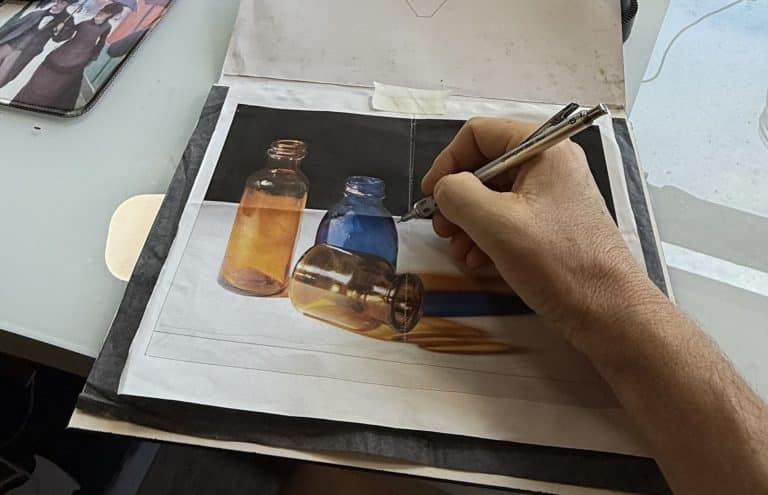
Whether you’re painting in watercolor, oil, or acrylic, getting a clean, accurate drawing onto your working surface is often the first step toward a successful painting. Freehand drawing is a wonderful skill — but sometimes, especially for complex compositions or portraits, image transfer methods save time and preserve proportions.
Today, we’ll explore three tried-and-true ways to transfer your drawing or printed image onto your painting surface:
Carbon Paper
Saral Transfer Paper
Homemade Graphite Transfer Paper
Each has its quirks and best uses. Let’s dive in.
 1. Using Carbon Paper
1. Using Carbon Paper
Carbon paper is the classic, old-school method — and it still works beautifully.
 What You’ll Need
What You’ll Need
Your drawing or printed image
A sheet of carbon paper (graphite side down)
Your painting surface (watercolor paper, panel, canvas, etc.)
A pencil or stylus
 How to Do It
How to Do It
Tape your surface securely to your work table.
Place the carbon paper graphite-side down onto the surface.
Position your image on top, aligning it carefully.
Tape the image in place so it doesn’t shift while tracing.
Using a sharp pencil or stylus, trace over all the lines you want to transfer.
Gently lift a corner to check progress, then finish the rest.
 Pro Tips
Pro Tips
Use light pressure — carbon paper can be quite dark, and too much pressure can leave indents.
After transferring, lightly erase or soften the lines if they’re too bold before painting.
Best for: Canvas, panels, and heavy watercolor papers. Excellent when you need a quick, clear transfer.
 2. Using Saral Transfer Paper
2. Using Saral Transfer Paper
Saral paper is a modern, artist-friendly version of carbon paper. It comes in rolls or sheets and various colors (graphite gray, white, red, blue, etc.), which is perfect for different surfaces.
 What You’ll Need
What You’ll Need
Saral transfer paper (choose color for your surface)
Image and painting surface
Pencil or stylus
 How to Do It
How to Do It
Place Saral paper chalk-side down on your surface.
Tape it in place.
Position your image over it and tape that down too.
Trace over the lines you want to transfer.
 Why Artists Love Saral
Why Artists Love Saral
Erasable: Lines can be gently erased without damaging the surface.
No smudging: Unlike carbon paper, Saral doesn’t smear.
Reusable: One sheet can be used for multiple transfers.
Color choice: White works beautifully on dark panels; red or blue can be easier to see than graphite on light papers.
Best for: Watercolor paper, gessoed panels, toned grounds, and surfaces where smudge-resistance matters.
3  Why Make Your Own?
Why Make Your Own?
Commercial transfer sheets can be too dark or greasy, leaving unwanted residue that muddies washes. Homemade graphite paper gives you:
A cleaner line that lifts easily with a kneaded eraser.
Control over tone and pressure (no over-printing).
A reusable sheet that costs pennies to make.
 What You’ll Need
What You’ll Need
A sheet of tracing paper or lightweight drawing paper.
A soft graphite pencil — 4B to 6B works best.
A tissue or soft cloth.
Optional: a drop of rubbing alcohol or a hint of graphite powder for smoother coverage.
 How to Make It
How to Make It
Shade one side of the tracing paper with your soft graphite pencil, covering it evenly.
Use broad side strokes rather than tight lines — you’re creating a film, not a drawing.Buff the surface gently with a tissue to even out the graphite and remove loose dust.
This prevents smudges and gives a soft, consistent transfer.(Optional) Lightly spray the reverse side with a bit of workable fixative so it doesn’t mark your hands or sketchbook.
Your homemade graphite paper is now ready — store it between two clean sheets of paper and reuse it for months.
 How to Use It
How to Use It
Place the graphite sheet graphite side down on your painting surface.
Position your drawing or printed outline on top.
Trace the lines with a sharp pencil, stylus, or ballpoint pen using light, steady pressure.
Lift a corner occasionally to check progress — less pressure is better; you can always darken lines later.
When finished, remove the transfer paper and gently erase any excess graphite before painting.
 Pro Tip
Pro Tip
For watercolor, choose H- or HP-surface papers and keep the transfer lines as faint as possible — strong graphite lines can resist transparent washes or muddy your color. You can also make a “warm-tone” transfer sheet using a mix of sepia pastel and graphite, which disappears beautifully under earth colors.


